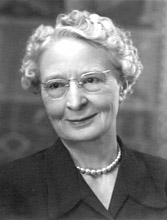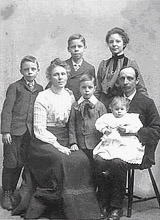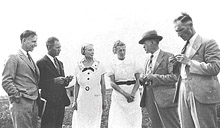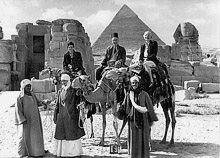
Margaret Newton
(Photo courtesy Agriculture and AgriFood Canada Cereal Research Center, Winnipeg). |
|
James A. Kolmer
USDA-ARS Cereal Disease Laboratory
Department of Plant Pathology
University of Minnesota
St. Paul, Minnesota 55108
Email: jkolmer@umn.edu
Kolmer, J.A. 2005. Margaret Newton: Pioneering Cereal Rust Researcher. Online. APSnet Features. doi: 10.1094/APSnetFeature-2005-0305


Fig. 1. Family of John Newton and Elizabeth Brown. Margaret Newton is standing behind her father. Courtesy of Craig Newton. |
|
Margaret Newton, the daughter of Elizabeth Brown and John Newton, was born on April 20, 1887 in Montreal, Quebec, Canada. Her father had been educated as a chemist in England, and worked as a laborer on the farm of his father-in-law at Plaisance, Quebec. Margaret’s education began in a one-room schoolhouse at North Nation Mills. Her father later moved the family of five children -- Margaret, Robert, John, William, and Dorothy (four were to obtain Ph.D. degrees in agriculture) -- and his wife (Fig. 1) to Montreal for a higher paying job at a box manufacturing and lumber firm. Margaret finished middle school and completed two years of high school in Montreal. She finished high school in Plaisance after the family returned there to live. After two additional years at a country school, Margaret taught for one year in the same schoolhouse that she had attended in North Nation Mills. Margaret was not yet fully qualified as a teacher, so she studied for two years at the Collegiate Institute in Vankleek Hill, Ontario, and obtained a teaching degree from the Normal School in Toronto. She taught for three years in Lachine, Quebec, and returned to teach for one year at the school in North Nation Mills.
During her teaching stints, Margaret became interested in obtaining a university degree. She initially enrolled in an arts program at McMaster University. During her first year at McMaster she visited her brother who was attending Macdonald College, at Ste. Anne de Bellevue, Quebec, which was the faculty of agriculture of McGill University. Margaret decided to change her field of study, and in 1914 applied for admittance to Macdonald College, with a major in agriculture. She was not immediately accepted, although her academic credentials were excellent. The most likely reason for this was that the women students who had been accepted the previous year were having difficulties in their class work. Eventually she was admitted to the agriculture degree program at Macdonald College.
As a woman student, Margaret had to deal with the prejudices of the era. At that time, the use of laboratories in the evening hours was restricted to male students; female students were simply not allowed. She did not tolerate this treatment for long. Margaret enlisted the support of her first mentor, W. P. Fraser, a rust mycologist at Macdonald College. Together, they petitioned the Dean of the College, and soon Margaret was allowed to use the laboratories in the evening hours. However this only partially solved the problem, as there was another rule that all female students had to be in their residences by 10 p.m.
In Margaret’s second year at Macdonald College, she took Fraser’s course in mycology and became interested in his research on cereal rust diseases of plants, which led her to study plant pathology. In the summer of 1917, Fraser went to the prairies of western Canada to survey for stem rust and other diseases of wheat. In his absence, Margaret was placed in charge of his collection of fungi and she also continued his cereal rust research. Fraser sent Margaret various collections of cereal rust, which she tested for host range with different species of grasses. During this time, she was visited by Charles Saunders, the Dominion Cerealist at the Central Experimental Farm in Ottawa. Saunders had recently developed the wheat cultivar Marquis, which was the first modern spring wheat bred in North America with high quality bread-making characteristics. Saunders gave Margaret some seed of Marquis wheat, from which Margaret grew seedling plants for testing with different single-spore isolates of stem rust, Puccinia graminis. The results were surprising. Not all of the stem rust isolates had the same degree of infection to Marquis wheat. Margaret repeated the experiment and obtained the same results. When Fraser returned, she told him of the results. Margaret and Fraser soon developed the hypothesis that the stem rust fungus was genetically variable, and was composed of more than one strain or race. Working independently, with little supervision, Margaret demonstrated the phenomenon of physiologic specialization, which had also been recently demonstrated by E. C. Stakman at the University of Minnesota in St. Paul.
Margaret also proved to be an outstanding classroom student at Macdonald College. She was awarded the Governor General’s bronze medal at the end of her second year for highest academic standing in her class. She was also president of the Literary Society from 1916 to 1917. Margaret graduated in 1918, the first woman to obtain a bachelor’s degree in agriculture from Macdonald College.
In the summer of 1918, Margaret went to Winnipeg, Manitoba, to assist Fraser in the study of cereal rust diseases. She worked in the greenhouse facilities of the University of Manitoba and was employed by the Brandon Research Laboratory of the Federal Department of Agriculture. Margaret returned to Macdonald College where she continued her research on wheat stem rust. She completed an M.S. degree in 1919; the title of her thesis was “The Resistance of Wheat Varieties to Puccinia graminis.” While Margaret finished her thesis, W. P. Thompson, a wheat breeder at the University of Saskatchewan determined that one of his new wheat varieties was resistant at one location, but was susceptible at another. Thompson discussed the problem with Fraser, who informed him of Margaret’s and Stakman’s discoveries that different virulent forms of wheat stem rust existed. Based on these data, the best explanation was that different races of stem rust were at the two locations. As a result of this, Thompson became very interested in cereal rust research and in Margaret’s work in particular.
As a result of her research skills and already notable achievements, Thompson and Stakman were both interested in having Margaret continue her work with wheat stem rust in their respective laboratories. Margaret wished to continue her graduate studies with Stakman at Minnesota, but initially lacked the means to support herself while she would be in St. Paul. During her time at Macdonald College, Margaret was informed that the Honorary Advisory Council for Scientific and Industrial Research of Canada would provide funding for her studies in Minnesota. Thompson was still interested in having Margaret work with himself and Fraser, who now had taken a position with the Federal Department of Agriculture in Saskatoon. Thompson conferred with Stakman, and it was arranged that Margaret would spend six months of the year in St. Paul and six months in Saskatoon while she was enrolled in a Ph.D. program at Minnesota. Although this would delay completion of her graduate studies, Margaret agreed to the arrangement since she would be able to work with Stakman, Thompson, and Fraser, three of the pre-eminent cereal rust researchers of the day.
Margaret Newton went to Saskatoon in 1920 as an Assistant Plant Pathologist at the Dominion Laboratory of Plant Pathology, located on the campus of the University of Saskatchewan. There she was visited by Stakman, who had brought seed of the wheat cultivars and varieties that were used to differentiate races of P. graminis. Her Ph.D. thesis was entitled “Studies in wheat stem rust (Puccinia graminis tritici).” The first part of the thesis described the distribution of 14 races of wheat stem rust in western Canada and the host range of the races on 29 species of grasses. The second part was a histological study of the stem rust infection process on resistant and susceptible wheat hosts. Margaret graduated from Minnesota with a Ph.D. in Plant Pathology in 1922, the first Canadian woman with a doctorate in agricultural science (Fig. 2).
| |

Fig. 2. Department of Plant Pathology, University of Minnesota, 1922. Margaret Newton is seated in the first row, second from the left, next to E. C. Stakman. Courtesy of Department of Plant Pathology, University of Minnesota. |
|
Margaret returned to Saskatoon in 1922 and was appointed as an assistant professor in the Department of Biology at the University of Saskatchewan. During this time she continued research with Thompson and Fraser, working on identification of wheat stem rust races, the effect of light and temperature on spore germination and infection, and the size of stomatal openings in stem rust resistant and susceptible hosts.
Major stem rust epidemics on wheat occurred in western Canada in 1916, 1919, and 1921. These provided the initiative to fund additional cereal rust research in Canada. In 1924, federal funds were allocated to build the Dominion Rust Research Laboratory, located on the campus of the University of Manitoba in Winnipeg. The Federal Minister of Agriculture, W. R. Motherwell, offered Margaret a position at the new Winnipeg lab where she would be responsible for conducting research on physiologic specialization in P. graminis. Margaret accepted the offer and left Saskatoon for Winnipeg in the summer of 1925.
At the “Rust Lab” in Winnipeg, Margaret soon proved to be a productive and formidable research scientist. One of the attractions of her position in Winnipeg was that she had the freedom to choose her assistant. She hired Thorvaldur Johnson (Fig. 3), who would also obtain a Ph.D. in Plant Pathology from the University of Minnesota. J. H. Craigie, also working at the Dominion Rust Research Laboratory, had very recently determined that P. graminis was heterothallic and that sexual recombination occurred in the pycnial infections of the fungus on barberry. With this knowledge, Margaret and Johnson were able to conduct the first genetic studies in P. graminis. Many questions regarding the genetic nature of wheat stem rust races needed to be answered: were the physiologic forms heterozygous or homozygous; were different races capable of crossing; and did Mendelian factors determine the genetics of physiologic races? In a remarkable series of experiments, Margaret and Johnson selfed and crossed a large number of wheat stem rust races and tested the progeny isolates for virulence to the wheat stem rust differential hosts. These results indicated that most wheat stem rust races were heterozygous for virulence. For example, race 53 when selfed gave rise to 18 different races. The brick-red spore color of wild type rust urediniospores was determined to be conditioned by two independent genes. A unique low infection type on Marquis was shown to be inherited in a cytoplasmic manner, as determined by infection types of progeny isolates derived from reciprocal crosses. The genetic studies also indicated that P. graminis isolates with the same race designation could be genetically distinct.
| |

Fig. 3. Left to right; Frank Greaney, E. C. Stakman, Margaret Newton, Johanna Becker, John H. Craigie, and Thorvaldur Johnson. Although formally dressed, they appear to be in a field. Courtesy of AgriFood and Agriculture Canada, Cereal Research Centre, Winnipeg. |
|
Margaret and Johnson were the first to demonstrate Mendelian inheritance of virulence in a plant pathogenic fungus. Isolates of wheat stem rust race 9 and race 36, which differed for infection to the wheat cultivars Kanred, Mindum, and Vernal, were crossed and the F1 and F2 isolates were tested for virulence to the three wheat cultivars. The F2 progeny isolates segregated for a single dominant gene controlling virulence to Kanred, for a single recessive gene for virulence to Mindum, and for two dominant genes that conditioned virulence to Vernal. Margaret and Johnson concluded that the virulence of the races was inherited according to Mendelian laws, genes that conditioned infection type could be either dominant of recessive, genes in P. graminis that conditioned virulence segregated independently, and isolates with the same race designation could be genetically distinct. These results are all the more remarkable and insightful in that Harold Flor had not yet completed the work from which he would formulate the gene-for-gene hypothesis. The experiments and published papers of Margaret Newton and Thorvaldur Johnson remain as the most thorough examination of genetics of a cereal rust pathogen.
While at the Rust Lab, Margaret also conducted research on stripe rust of wheat, caused by P. striiformis, and leaf rust, caused by P. triticina. She conducted the physiologic race surveys of both P. graminis and P. triticina in Canada, and tested wheat cultivars for resistance to stem rust and leaf rust. Her work on physiologic specialization of wheat stem rust was critical to the successful effort to develop stem rust resistant wheat cultivars in Canada. With Johnson and other co-authors, she published 42 research papers and 11 abstracts. Her expertise in rust research led to numerous visits from international scientists and trips abroad. A most notable visitor was the Russian scientist Nikolai Vavilov. Vavilov was so impressed by Margaret that he offered her a position on his staff in Lenningrad. After careful consideration, Margaret declined the offer and chose to remain in Winnipeg. Margaret later traveled alone to Russia to visit Vavilov in 1933, and discussed with Russian scientists methods for working with the cereal rust fungi.
As an ambitious scientist, Margaret Newton often had multiple projects underway and at times felt driven to publish results before the studies were fully completed. Her major collaborator, Thorvaldur Johnson, had a different perspective and felt that the results needed to be completely verified before publication. This led to a minor friction between the two, yet obviously did not seriously affect their friendship and fruitful collaboration. In a letter written after her retirement, Johnson wrote “... she had a great capacity for work and more ambition than most people ... she had ... the quality often referred to as ‘drive’.” In a letter written later to Margaret, Johnson also wrote: “... I understand now, what I did not fully understand before, that my attitude towards research is something I acquired from you.” (Thorvaldur Johnson, unpublished memoirs).
Margaret Newton continued as a scientist at the Dominion Rust Laboratory in Winnipeg until 1945. Her long-term exposure to stem rust spores led to respiratory and allergenic problems that effectively forced her to retire. The Canadian government hesitated to give Margaret a full pension since she had retired somewhat early. However, western Canadian grain farmers showed their appreciation for her by petitioning the government; “This woman has saved the country millions of dollars.” Margaret was granted a full pension. After enduring many Winnipeg winters, she retired to the milder climes of Victoria, British Columbia.

Fig. 4. Margaret Newton with her brother and his wife while in Egypt. Courtesy of Craig Newton. |
|
During her career and in retirement, Margaret received honors and awards for her research. For her internationally recognized work in cereal rusts, Margaret was elected to the Royal Society of Canada in 1942, only the second Canadian woman to be so honored. She was also awarded the Flavelle Medal in 1948 by the Royal Society. In 1956 the University of Minnesota awarded her the Outstanding Achievement Award, an all-University award restricted to former students who have achieved eminence in their fields. In 1969 she was awarded an honorary L.L.D. by the University of Saskatchewan. The University of Victoria named a student residence “Margaret Newton Hall.” She traveled to the International Botanical Congress in Sweden and to the International Federation of University Women conference in Switzerland, both in 1950. At some time in retirement she also traveled to Egypt (Fig. 4). Margaret remained active in retirement, with birding, canoeing, and gardening among her hobbies. She also participated in various social organizations in Victoria. Besides her research she was interested in natural history, arts, and music. Throughout her life many knew her for her kindness, friendship, and generosity. Margaret Newton died in Victoria, British Columbia on April 6, 1971. In 1991 Margaret Newton was elected to the Science Hall of Fame in Ottawa, Ontario, Canada.
Acknowledgement
Much of the information on Newton's personal life and career before her studies at the University of Minnesota are indebted to:
Estey, Ralph. 1990. Margaret Newton: Distinguished Canadian Scientist. Pages 236-247 in: Despite the Odds: Essays on Canadian Women and Science. M. Gosztonyi Ainley, ed. Véhicule Press, Montreal.
Additional Resources
Celebrating Women’s Achievements:
Canadian Women in Science -- Margaret Newton
Herstory: An Exhibition -- Agriculture: Margaret Newton
Margaret Newton: Defeating Wheat Rust Disease, 1887–1971
Inventive Women: Dr. Margaret Newman
